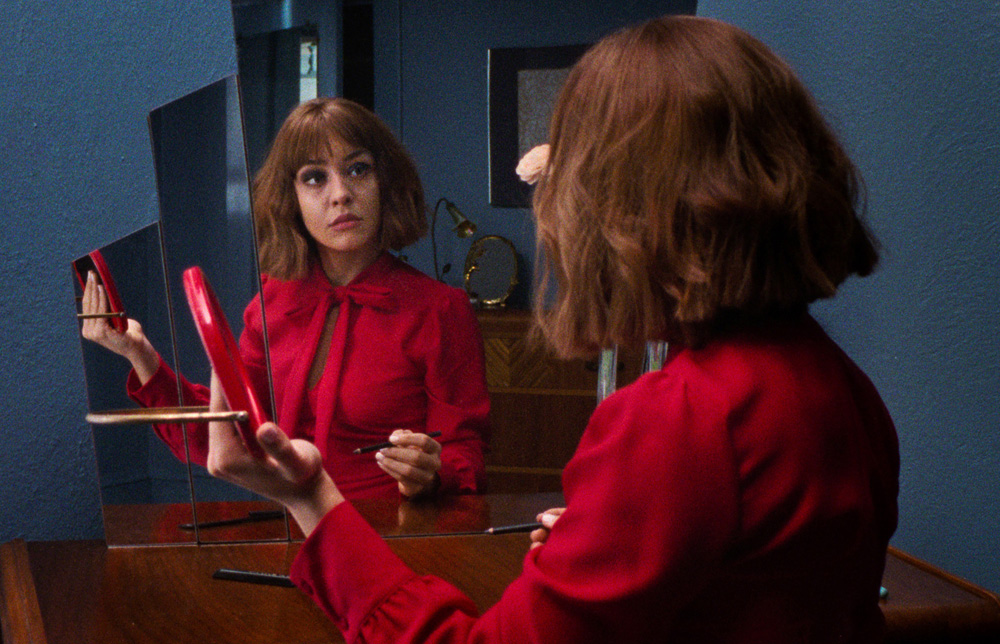“You have to cut the dead parts so it’ll grow back,” Vivian (Animari Mesa) informs her sister Marian (Alessandra Mesa) in “Superior,” speaking perhaps about how best to prune the shrubbery in the backyard, but the words settling more deeply when Marian has just eluded a dangerous ex-boyfriend (Pico Alexander) and has found refuge at her twin’s suburban home in upstate New York, though she isn’t about to tell her what’s actually going on. In Erin Vassilopoulos’ electric feature debut, Vivian could trim some things from her own life as well, bored in a marriage to a man (Jake Hoffman) whose idea of fun is collecting vintage tobacco tins though he’d never want to smoke and slightly envious of her sister who got to gallivant across Europe with her band, though she’s far too sensible herself to let herself go like that. Still, after six years apart, the sisters have more in common than it would first appear and when the opportunity arises to switch places for a day with no one being the wiser, they get to see a part of the other’s life that has been just out of reach before.
“Superior” would be fascinating under any circumstances, but particularly so in relation to the 2015 short it’s an extension of, first visiting Vivian and Marian as teens under the thumb of their father and although its unnecessary to watch to enjoy the feature, a kicky delight that makes great use of its ominous setting around Halloween in 1987, the notion that these sisters feel trapped at yet another point in their life in spite of any physical agency they may have becomes quite powerful. Using the frisson of 16mm film to capture the bottled up tension between the twins, who being real-life siblings bring a unique energy all their own, Vassilopoulos pitches a frustration with the roles Marian and Vivian are assigned to play in their lives as if it were a horror film, recalling other contemporary subversions on the tropes of their genre such as Anna Biller’s “The Love Witch” and Ti West’s “The House of the Devil” that are so conscious of what’s come before that they become something entirely new.
Alternately endearing and chilling as a result, “Superior” may be a tale of those believing there’s greener grass to be found elsewhere, but there’s nowhere you’d rather be yourself than inside Vassilopoulos’ thoughtfully constructed thriller and on the eve of its premiere at Sundance, the director spoke about working deliberately towards her first feature, crafting the film’s bewitching style with cinematographer Mia Cioffi Henry and composer Jessica Moss and finding the film’s eye-catching central location.
When you were making the short, did you actually have this larger story in mind? It’s a fascinating extension.
I didn’t, partially because I was still in film school at the time and I knew that I needed to keep practicing. I hadn’t written a feature yet, so I made a couple of other shorts after [the short version of] “Superior” and then the feature came about because in the process of making the short, I had become really close with our leads Ani and Alessandra Mesa. Eventually over time, I think we all just had such a good experience making the short and loved that world and the characters that we wanted to work together again. So it took a few years before Alessandra and I eventually got together and talked about expanding the world into a feature. After acting in the short, [Alessandra] had also gotten more into screenwriting, so it was an organic progression. I always knew shorts are such a different form from a feature, I didn’t want to just stretch the short into a feature, but we both felt really excited about the idea of creating a jump in time and picking up the story with the same sisters years later as adults.
What was it like collaborating with the Mesa sisters over that time?
It was a lot of fun and it was really pretty fluid. Because we had gotten to know each other so well on the short, there was a lot of trust and just excitement about continuing this story in this world. Obviously as identical twin sisters, they had a lot to bring to the table and partially because the short is so heightened — I always felt like it takes place in this parallel universe, it’s not exactly reality — we did always know that these characters are not totally based on them and they had fun with that. They both got to explore. [These are] people in a lot of ways really different from themselves, but at its core, the movie’s about the relationship between the sisters and I think a lot of the scenes and the questions in both the short and the feature are things that Ani and Alessandra have gone through and grappled with, so there’s definitely a lot of their relationship in the movie as well.
This may be a chicken and the egg question, but because of that heightened reality, you can tell how diametrically opposed they are at first simply in their style. Could that actually help you figure out the emotional arcs of the characters or was it the reverse? The short really established some strong ideas.
Yeah, we structured in the movie as these dual narratives where we had one sister [Marian] caught up more and she’s on the run and she’s hiding out — that’s why she comes home, and I always knew that aspect of the story would be more thriller-esque. Then on the flip side, the other sister [Vivian] is at home, trying to have a baby, questioning her role in the domestic sphere. So very early on, I knew that there would be these two very different styles and that those would intersect when Marian comes home and is staying with her sister again. So that was definitely inherent to the story from the beginning and helped us map out the trajectory of each character.
Did you actually find one central house that you could paint all of the rooms in? It didn’t look like you strung together a bunch of sets, but it’s a crazy place.
Yeah, the house took a while to find, but I actually start scouting really early on and when we were still writing, I was starting to drive upstate and look at locations. So much of the movie takes place in this one house, and that house [in the film] already had a lot of the feel, [if] not the colors exactly. It’s a very odd house. And we were super lucky it was on the market, so the owners were [already] selling this house, but they were really cool and let us paint. We built a little garden in the backyard. But the way it is in the movie is pretty much how we found it and I was very excited when I first walked in that house. I was like, “Oh, this is so good.”
You’ve worked a lot with the cinematographer Mia Cioffi Henry, who has a really exciting style of fixed points of view and very deliberate camera movements. What was it like to develop the language for this?
It was great to be able to continue that because we had worked on a few shorts together, so we have developed a visual language together. And it was really helpful to reference the short in a lot of ways because the short is very stagnant, but then there’s these dreamier moments that become a little more fluid and handheld, so we were definitely continuing that style, but at the same time, a feature is so much bigger. There’s just so much more material that we naturally had to expand on what our approach to the short [was], so we set some rules for ourselves early on and then often we could get on set and start trying things and like if something wasn’t working. We also gave ourselves a room to switch gears and do what we felt was needed for the scene in the moment.
The stagnant camera was [because] a lot of the movie’s about these two women who feel trapped in different ways and so much of it takes place in this house, so we definitely wanted the house to feel claustrophobic. And then in these dreams or nightmares that Marian has, it opens up and becomes more handheld and looser. I definitely wanted those moments to feel distinct from everything else. We also talked a lot about zooms very early on. I knew I wanted there to be a lot of zooms in the movie, so we knew that that would be a recurring shot that we would use, especially for the more thriller aspects of the movie.
The music also contributes greatly to the overall narrative. Was there a strong plan from the start?
Yeah, I became aware of Jessica Moss’ music when we were writing the script, I actually went to a concert and I had never heard of her at that point, but she opened and performed this piece called “Particles” that [became] the theme song in the movie and hearing that while I was writing the script, it just really synced up. I was just immediately convinced like this song needs to be the spine of the movie, so I approached her right after the show. She probably thought I was crazy. I was like, “Do you score films?” But we started a dialogue that night and then ultimately she scored the film, but also some of her recorded pieces like [“Particles”] are in it, so that came about very early. Then the eighties music came about more in post. It was a long process of licensing music and finding music that I was really excited about that we could also afford the license. But that was a big part of the process. It’s a very musically driven film.
What’s it’s like to have a feature under your belt and getting it out there?
I’m so excited and just so grateful that we were able to shoot this before the pandemic, before everything shut down. It was really great to have a movie to get to slowly work on this past year, and I’m so humbled and honored to be sharing it at Sundance for the first time.
“Superior” will screen at the Sundance Film Festival for a 48-hour window starting on January 31st at 4 am MT.




